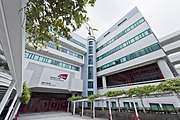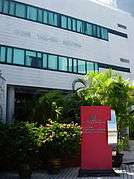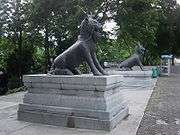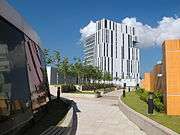City University of Hong Kong
City University of Hong Kong (CityU) is a public research university in Kowloon, Hong Kong. It was founded in 1984 as City Polytechnic of Hong Kong and became a fully accredited university in 1994. It is one of eight government-funded degree-granting tertiary institutions.
香港城市大學 | |
 | |
| Motto | 敬業樂群 (Traditional Chinese) Officium et Civitas (Latin)[1] |
|---|---|
| Type | Public |
| Established | 1984 (as City Polytechnic of Hong Kong) 1994 (full university status) |
| Chairman | Lester Garson Huang |
| Chancellor | Chief Executive of Hong Kong (Current officeholder: Carrie Lam) |
| President | Way Kuo |
Academic staff | 845 |
| Students | Associate Degree: 903[2] Undergraduate: 12,878[2] Taught Postgraduate: 5,082[2] Research Postgraduate: 1,278[2] Professional Doctorate: 142[2] |
| Location | |
| Campus | Urban, 15.6 hectares (0.156 km2) |
| Colours | Bold burgundy[4] |
| Affiliations | ASAIHL, International Association of Universities, UGC, UAiTED |
| Website | cityu |
| City University of Hong Kong | |||||||||||||||
|---|---|---|---|---|---|---|---|---|---|---|---|---|---|---|---|
| Traditional Chinese | 香港城市大學 | ||||||||||||||
| Simplified Chinese | 香港城市大学 | ||||||||||||||
| Cantonese Yale | Hēunggóng Sìhngsíh Daaihhohk | ||||||||||||||
| |||||||||||||||
| University rankings | |
|---|---|
| Global – Overall | |
| ARWU World[5] | 201-300 (2018) |
| THE World[6] | 119 (2018) |
| QS World[7] | 48 (2021) |
| Regional – Overall | |
| THE Asia[8] | 14 (2018) |
| QS Asia[9] | 21 (2019) |
The university has five colleges and four schools: the College of Business, College of Engineering, College of Liberal Arts and Social Sciences, College of Science, Jockey Club College of Veterinary Medicine and Life Sciences, and the School of Creative Media, School of Data Science, School of Energy and Environment and School of Law.
As of 2020, CityU ranks 19th in Asia by THE, 5th in young universities, and 48th internationally by QS.[10][11][12]
History
City University's origins lie in the calls for a "second polytechnic" in the years following the 1972 establishment of the Hong Kong Polytechnic. In 1982, Executive Council member Chung Sze-yuen spoke of a general consensus that "a second polytechnic of similar size to the first should be built as soon as possible."[13] District administrators from Tuen Mun and Tsuen Wan lobbied the government to build the new institution in their respective new towns.[13] The government instead purchased temporary premises at the new Argyle Centre Tower II in Mong Kok, a property developed by the Mass Transit Railway Corporation in concert with the then-Argyle Station. The new school was called City Polytechnic of Hong Kong, a name chosen among nearly 300 suggestions made by members of the public.[14]
The new polytechnic opened on 8 October 1984, welcoming 480 full-time and 680 part-time students.[15] The provision for part-time students contributed to high enrolment, with the quota being filled almost immediately.[15]
The architectural contract to design the new campus was won by Percy Thomas Partnership in association with Alan Fitch and W.N. Chung.[16] It was originally slated to open by October 1988.[17] The first phase was officially opened by Governor Wilson on 15 January 1990, and boasted 14 lecture theatres and 1,500 computers.[18] By 1991, the school had over 8,000 full-time students and approximately 3,000 part-time students.[19] The second phase of the permanent campus opened 1993.[16] The school achieved university status in 1994 and the name was changed accordingly.[20]
In April 2015 the university abruptly and controversially shut down its MFA programme in creative writing. Students and alumni launched a petition against the decision, while the faculty and noted international writers issued an open letter questioning the reasoning behind the closure.[21] Acclaimed Canadian novelist and faculty member Madeleine Thien, writing in The Guardian, was among those who attributed the decision to censorship and diminishing freedom of expression in Hong Kong.[22]
In 2017 City University was accused of falsifying student data for a better ranking.[23][24] City University said they would submit the case to external audit firm to verify the data.[24]
Campus
City University of Hong Kong is located on Tat Chee Avenue, Sham Shui Po District,[25] Kowloon. It is near Kowloon Tong Station, which serves the East Rail Line and Kwun Tong Line of Hong Kong's Mass Transit Railway (MTR) system. It is also adjacent to Shek Kip Mei Park, Nam Shan Estate and the Festival Walk shopping centre. The main campus covers around 15.6 hectares.
The Run Run Shaw Creative Media Centre is an academic building on the campus, which was completed in 2011. It was designed by Daniel Libeskind cooperating with Leigh and Orange Ltd., and received several awards on its design.[26] It was funded with a donation of HK$100 million from the Shaw Foundation and is named after Run Run Shaw.[27] The building houses the university's School of Creative Media, the Centre for Applied Computing and Interactive Media and the computer science, media and communication, and English departments.[28]
Hu Fa Kuang Sports Centre is a five-storey sports centre which houses a multi-purpose hall and four practice gymnasiums for badminton, basketball, volleyball, martial arts and dance, and other activities. In May 2016, the 1,400 square metre roof of the Chan Tai Ho multi-purpose hall at the sports centre which had been covered with a living roof just completed for two months suddenly collapsed, injuring three people.[29]
Governance
The governing council comprises 23 university members. The chief executive of Hong Kong has the power to appoint 15 of the 23 council members, seven of which are named directly and eight appointed upon recommendation of the council. The chief executive can also appoint the chairman, deputy and treasurer.; the vice-chancellor is in turn appointed by the council.[30]
Gallery
 Yeung Kin Man Academic Building
Yeung Kin Man Academic Building Run Run Shaw Library
Run Run Shaw Library Bank of China (Hong Kong) Complex and swimming pool
Bank of China (Hong Kong) Complex and swimming pool- CityU Circle
 Cheng Yick-Chi Building
Cheng Yick-Chi Building Qilins, Front Entrance, CityU
Qilins, Front Entrance, CityU CityU AC2 Roof Garden
CityU AC2 Roof Garden CityU Academic 3
CityU Academic 3 Aerial view from CityU Student Residence
Aerial view from CityU Student Residence- Aerial view from City University of Hong Kong main campus
 CityU Student Residence Room
CityU Student Residence Room Run Run Shaw Creative Media Centre
Run Run Shaw Creative Media Centre
Alumni
- Christopher Cheung – CEO of Christfund Securities and Legislative Councilor[31]
- David Chung Wai-keung – Undersecretary for Innovation and Technology Bureau[32]
- Kam Nai-wai – Legislative Councilor[33]
- Christine Loh – Undersecretary for the Environment[34]
- Bona Mugabe – Daughter of former President of Zimbabwe and ZANU-PF leader, Robert Mugabe[35]
- Paul Tse – Legislative Councilor[36]
- Lau Kong-wah – Undersecretary of the Constitutional and Mainland Affairs Bureau, Former Legislative Councilor[37]
- Matthew Wong - Internationally-Acclaimed painter[38][39]
Controversies
QS Ranking Dispute
City University of Hong Kong has been accused of providing misleading information to Quacquarelli Symonds (QS) to boost its university rankings. Review of the QS university rankings over the past three years showed that City University of Hong Kong has shrunk its student population by 14.7 percent from 2015 and 27.4 percent from 2016. However, the spokesperson of City University of Hong Kong denied that the student count was made during summer, adding that the QS employs independent firms to verify the data submitted by universities. Kuo Way, the President of City University of Hong Kong, has also asked an independent firm to review the CityU figures.
Intervention of students' academic autonomy
In October 2019, Prof Tan Yong Chin who was teaching a digital marketing course sent an email to the students, which warned the students not to deliver any political messages in class presentations or they will be given zero marks. The e-mail caused dissatisfaction among the students. Some of them thought that their presentation were solely integrating the related course content with the recent social issues, while they did not call slogans in the classroom or affect the classroom order. They questioned Tan for creating white terror.[40]
- The Student Union of CityU cross-checked the University Assessment Policy and Principles for Taught Programmes, and considered the marking policy of Tan to be violating the policy of the university and the university's promise of protecting freedom of speech[41]
- Pro-democracy group Frontline Technology Workers pointed out that the relevant presentations were highly relevant to the course although it was touching the social controversies and criticized the professor for creating troubles and dispute.[42] They also highlighted many academic journal articles which discussed the relationship between politics and marketing.[43][44][45]
See also
References
- "University Motto". City University of Hong Kong. Archived from the original on 20 January 2015. Retrieved 17 July 2014.
- "Student Numbers (2014/15)". Office of the Provost. City University of Hong Kong. Archived from the original on 28 July 2012. Retrieved 6 August 2015.
- https://www.cityu.edu.hk/cityu/geninfo/siteinfo.htm#contact
- "New CityU marketing logo launched in support of Strategic Plan 2015–2020". City University of Hong Kong. Retrieved 6 August 2015.
- Academic Ranking of World Universities 2018
- World University Rankings 2018
- QS World University Rankings 2021
- Asia University Rankings 2018
- QS Asian University Rankings 2019
- "QS Top 50 Under 50 2020". Top Universities. 25 June 2019. Retrieved 18 August 2019.
- "City University of Hong Kong". Top Universities. 13 June 2020. Retrieved 13 June 2020.
- "QS Top 50 Under 50 2020". Top Universities. 25 June 2019. Retrieved 11 September 2019.
- Chan, Garmen (10 May 1982). "Districts launch polytechnic lobby". South China Morning Post.
- "It's City Polytechnic...with degree courses". Hong Kong Standard. 26 April 1983.
- "City Poly opens doors to over 1,000 students". Hong Kong Standard. 10 October 1984.
- "City University of Hong Kong". Education. Percy Thomas Architects.
- "Final poly plans designed to please". South China Morning Post. 31 August 1983.
- Flahavin, Paulette (15 January 1990). ""Silicon Tong" role predicted as polytechnic campus opens". Hong Kong Standard.
- Chan, Fiona (8 April 1991). "City Polytechnic forced to retrench". South China Morning Post.
- "Cap 1132 - City University of Hong Kong Ordinance" (PDF). Bilingual Laws Information System. Department of Justice.
- "Open letter from faculty and international writers". Save CityU MFA. Retrieved 21 December 2016.
- Thien, Madeleine (18 May 2015). "Why Hong Kong is clamping down on creative writing". The Guardian.
- "CityU to launch independent audit after accusations it submitted false student numbers to boost int'l ranking | Hong Kong Free Press HKFP". Hong Kong Free Press HKFP. 13 November 2017. Retrieved 11 April 2018.
- 被質疑向QS報細學生數 城大交會計師行審查. Ming Pao (in Chinese). Media Chinese International. 13 November 2017. Retrieved 4 October 2018.
- "Sam Shui Po District" (PDF). Electoral Affairs Commission. Retrieved 30 August 2019.
- "The Run Run Shaw Creative Media Centre". Libeskind. Retrieved 4 October 2018.
- "Run Run Shaw Creative Media Centre, City University of Hong Kong". Designbuild. Retrieved 4 October 2018.
- Lee, Ashley (11 November 2011). "ArtAsiaPacific: Run Run Shaw Creative Media Centre". ArtAsiaPacific Magazine.
- "Questions mount over City University roof collapse investigation panel after vice-president withdraws".
- "Unsafe harbour? Academic freedom in Hong Kong". 9 September 2015.
- "Hon Christopher CHEUNG Wah-fung, SBS, JP". Members' Biographies. The Legislative Council Commission. Archived from the original on 11 October 2014. Retrieved 6 October 2014.
- "HK Govt Press Release".
- "KAM Nai Wai's Profile". 2008-2012 Work Report of Legislative Councillor KAM Nai-Wai. Retrieved 6 October 2014.
- "Curriculum Vitae - CHRISTINE LOH" (PDF). Civic Exchange. Retrieved 6 October 2014.
- "Zimbabwe's next leader: Who is Bona Mugabe-Chikore, Robert Mugabe's possible successor?". IB Times. Retrieved 6 October 2014.
- "Hon Paul TSE Wai-chun, JP". Members' Biographies. The Legislative Council Commission. Archived from the original on 11 October 2014. Retrieved 6 October 2014.
- "Hon LAU Kong-wah". Member of the Legislative Council. The Legislative Council Commission. Archived from the original on 25 April 2006. Retrieved 6 October 2014.
M. Phil., City Polytechnic of Hong Kong
- "Matthew Wong's Hallucinatory Pilgrimages". Hyperallergic. 22 April 2018. Retrieved 6 June 2020.
- Smith, Roberta (24 December 2019). "A Final Rhapsody in Blue From Matthew Wong". The New York Times. ISSN 0362-4331. Retrieved 6 June 2020.
- "修例風波:禁學生簡報宣揚政治 城大教授被質疑製白色恐怖". on.cc東網 (in Chinese). Retrieved 10 November 2019.
- "香港城市大學學生會 City University of Hong Kong Students' Union". www.facebook.com (in Chinese). Retrieved 10 November 2019.
- "前線科技人員". www.facebook.com (in Chinese). Retrieved 10 November 2019.
- Botha, Elsamari (1 June 2014). "A means to an end: Using political satire to go viral". Public Relations Review. Public Relations and Communication Management in South Africa. 40 (2): 363–374. doi:10.1016/j.pubrev.2013.11.023. ISSN 0363-8111.
- Holbert, R. Lance; Hmielowski, Jay; Jain, Parul; Lather, Julie; Morey, Alyssa (1 March 2011). "Adding Nuance to the Study of Political Humor Effects: Experimental Research on Juvenalian Satire Versus Horatian Satire". American Behavioral Scientist. 55 (3): 187–211. doi:10.1177/0002764210392156. ISSN 0002-7642.
- Moufahim, Mona; Humphreys, Michael; Mitussis, Darryn; Fitchett, James (1 June 2007). "Interpreting discourse: a critical discourse analysis of the marketing of an extreme right party". Journal of Marketing Management. 23 (5–6): 537–558. doi:10.1362/026725707X212829. ISSN 0267-257X.
External links
| Wikimedia Commons has media related to City University of Hong Kong. |